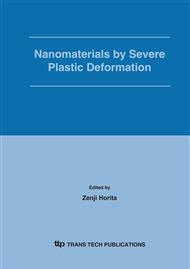p.633
p.639
p.645
p.651
p.657
p.663
p.669
p.675
p.681
Enhanced Ductility due to Grain Refinement by Equal Channel Angular Extrusion in Automotive Aluminium Alloy 6016
Abstract:
Equal Channel Angular Extrusion (ECAE) with varying levels of applied backpressure was used to refine the microstructure of commercial automotive aluminium alloy 6016 at room temperature using route BC and a 90° die. Before processing, the alloy was solution heat treated at 560°C for 1 hour to produce an initial average grain size of ~190μm (in the furnace cooled condition) and ~200μm (in the water quenched condition). Two needle-like secondary phase precipitates were observed predominantly at grain boundaries and identified as α-Fe Al12Fe3Si2 and β-Fe Al5FeSi. The ability of Al 6016 to accumulate strain by simple shear was found to be dependent upon both the heat treatment condition and level of applied backpressure. The furnace cooled (FC) condition was found to accumulate higher strains than the cold water quenched (WQ) condition (under the same applied backpressure) with higher levels of backpressure allowing both conditions to accumulate greater equivalent plastic strains. A series of static annealing experiments were performed on as-processed material to investigate the grain stability of the ultrafine grained structure obtained after ECAE. Grain growth was observed to occur at 250°C in the FC condition of Al 6016 after 12 passes of ECAE where the average grain size approached 1μm. The engineering strain to failure in elevated temperature tensile testing was found to be dependent upon the number of passes of ECAE, test temperature, strain rate and level of applied backpressure. Increasing the number of passes and level of applied backpressure during ECAE and decreasing the strain rate during testing was found to produce the greatest tensile ductilities at 200°C (FC condition) and 300°C (WQ condition).
Info:
Periodical:
Pages:
657-662
Citation:
Online since:
January 2006
Authors:
Price:
Сopyright:
© 2006 Trans Tech Publications Ltd. All Rights Reserved
Share:
Citation:


